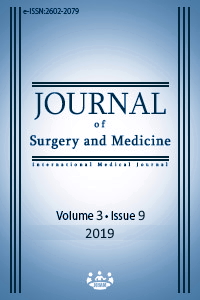Evaluation of changes in meibomian glands in polycystic ovary syndrome by noncontact infrared meibography
Keywords:
Dry eye, Meibography, Meibomian gland dysfunction, Polycystic ovarian syndromeAbstract
Aim: The human meibomian gland contains several overexpressed genes that are related to lipid dynamics and glandular structure. Meibomian gland dysfunction (MGD) was found to be associated with significant changes in these genes. The aim of this study was to compare the changes in meibomian glands in patients with polycystic ovary syndrome (PCOS) and healthy young women by non-contact meibography for the first time.
Methods: A total of 58 right eyes belonging to 28 patients with PCOS and 30 healthy women in the control group were included in this case-control study. The ocular surface and eyelid margins were evaluated with slit lamp examinations. Participants were asked about dry eye symptoms. Schirmer and tear film break time (TBUT) tests were performed consecutively. The morphology of the meibomian glands was observed with non-contact meibography and scored with the meiboscore.
Results: Dry eye symptoms were more prevalent and average TBUT was shorter in PCOS patients (p=0.001, p=0.02, respectively). However, Schirmer test results did not differ among the PCOS and control groups (p= 0.47). The meiboscores for upper eyelids and total eyelids were significantly higher in the PCOS group (P=0.001 and P=0.004, respectively), suggesting that PCOS is accompanied by meibomian gland dropout.
Conclusion: In this study, we found that the morphological status of the meibomian gland and the ocular surface were in worse condition in PCOS patients than in the normal controls, and we successfully observed the loss of meibomian gland in PCOS patients through non-contact meibography.
Downloads
References
Pelit A, Aydın P. Oküler yaşlanma. Geriatri. 2001;4:28-32.
Puderbach S, Stolze HH. Tear ferning and other lacrimal tests in normal persons of different ages. Int Ophthalmol. 1991;15:391-5.
Truong S, Cole N, Stapleton F, Golebiowski B. Sex hormones and the dry eye. Clin Exp Optom. 2014;97:324-36.
Rocha EM, Wickham LA, da Silveira LA, Krenzer KL, Yu FS, Toda I, et al. Identification of androjen receptor protein and 5alfa reductase mRNA in human ocular tissues. BJ Ophthalmol. 2000;84:76-84.
Nelson JD, Shimazaki J, Benitez-del-Castillo JM, Craig JP, McCulley JP, Den S, et al. The international workshop on meibomian gland dysfunction: report of the definition and classification subcommittee. Invest Ophthalmol Vis Sci. 2011;52(4):1930-7.
Rotterdam ESHRE/ASRM Sponsored PCOS Consensus Workshop Group. Revised 2003 consensus on diagnostic criteria and long-term health risks related to polycystic ovary syndrome (PCOS). Hum Reprod. 2004;19:41-7.
Arita R, Itoh K, Maeda S, Maeda K, Furuta A, Fukuoka S, et al. Proposed diagnostic criteria for obstructive meibomian gland dysfunction. Ophthalmology. 2009;116:2058-63.
Arita R, Itoh K, Inoue K, Amano S. Noncontact infrared meibography to document age-related changes of the meibomian glands in a normal population. Ophthalmology. 2008;115:911-5.
The definition and classification of dry eye disease: report of the Definition and Classification Subcommittee of the International Dry Eye WorkShop. Ocul Surf. 2007;5:75-92.
Ding J, Sullivan DA. Aging and dry eye disease. Exp Gerontol. 2012;47:483-90.
Arita R, Fukuoka S, Morishige N. Meibomian gland dysfunction and contact lens discomfort. Eye Contact Lens. 2017;43:17-22.
Ding J, Liu Y, Sullivan DA. Effects of insulin and high glucose on human meibomian gland epithelial cells. Invest Ophthalmol Vis Sci. 2015;56:7814-20.
Machalińska A, Zakrzewska A, Markowska A, Safranow K, Wiszniewska B, Parafiniuk M, et al. Morphological and functional evaluation of meibomian gland dysfunction in rosacea patients. Curr Eye Res. 2016;41:1029-34.
Suzuki T, Morishige N, Arita R, Koh S, Sakimoto T, Shirakawa R, et al. Morphological changes in the meibomian glands of patients with phlyctenular keratitis: a multicenter cross-sectional study. BMC Ophthalmol. 2016;16:178.
Schröder A, Abrar DB, Hampel U, Schicht M, Paulsen F, Garreis F. In vitro effects of sex hormones in human meibomian gland epithelial cells. Exp Eye Res. 2016;151:190-202.
Sulivan DA, Yamagami H, Liu M, Stegall RJ, Schirra F, Suzuki T, et al. Sex steroids, the meibomian gland and evaporative dry eye. In: David A. Sullivan, Michael E. Stern, Kazuo Tsubota, Darlene A. Dartt, Rose M. Sullivan, B. Britt Bromberg, editors. Lacrimal Gland, Tear Film, and Dry Eye Syndromes; 3. New York: Springer Science; 2002. p.389-400.
Yavas GF, Ozturk F, Kusbeci T, Ermis SS, Yilmazer M, Cevrioglu S, et al. Meibomian gland alterations in polycystic ovary syndrome. Curr Eye Res. 2008;33:133-8.
Baser G, Yildiz N, Calan M. Evaluation of meibomian gland dysfunction in polycystic ovary syndrome and obesity. Curr Eye Res. 2017;42:661-5.
Liu S, Richards SM, Lo K, Hatton M, Fay A, Sullivan DA. Changes in gene expression in human meibomian gland dysfunction. Invest Ophthalmol Vis Sci. 2011;52:2727-40.
Sheehan MT. Polycystic Ovarian Syndrome: Diagnosis and Management. Clin Med Res. 2014;2:13-27.
Amiri M, Ramezani Tehrani F, Nahidi F, Kabir A, Azizi F, Carmina E. Effects of oral contraceptives on metabolic profile in women with polycystic ovary syndrome: A meta-analysis comparing products containing cyproterone acetate with third generation progestins. Metabolism. 2017;73:22-35.
Azziz R. PCOS: a diagnostic challenge. Reprod Biomed Online. 2004;8:644-8.
Bonini S, Mantelli F, Moretti C, Lambiase A, Bonini S, Micera A. Itchy-dry eye associated with polycystic ovary syndrome. Am J Ophthalmol. 2007;143:763-71.
Nien CJ, Massei S, Lin G, Nabavi C, Tao J, Brown DJ, et al. Effects of age and dysfunction on human meibomian glands. Arch Ophthalmol. 2011;129:462-9.
Machalińska A, Zakrzewska A, Safranow K, Wiszniewska B, Machaliński B. Risk factors and symptoms of meibomian gland loss in a healthy population. J Ophthalmol. 2016;2016:7526120.
Den S, Shimizu K, Ikeda T, Tsubota K, Shimmura S, Shimazaki J. Association between meibomian gland changes and aging, sex, or tear function. Cornea. 2006;25:651-5.
Mizoguchi T, Arita R, Fukuoka S, Morishige N. Morphology and function of meibomian glands and other tear film parameters in junior high school students. Cornea 2017;36:922-6.
Downloads
- 1297 1742
Published
Issue
Section
How to Cite
License
Copyright (c) 2019 Yaran Koban, Rulin Deniz, Yakup Baykuş, Lokman Balyen, Hüseyin Çelik
This work is licensed under a Creative Commons Attribution-NonCommercial-NoDerivatives 4.0 International License.
















